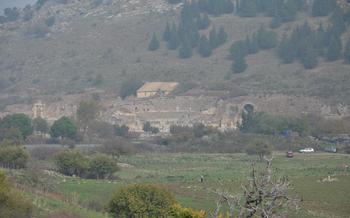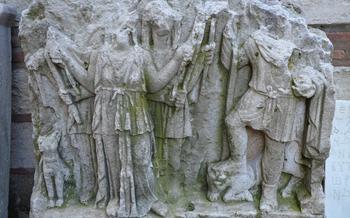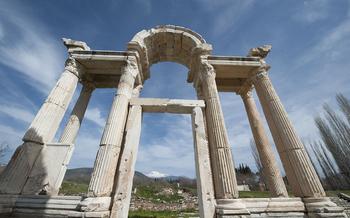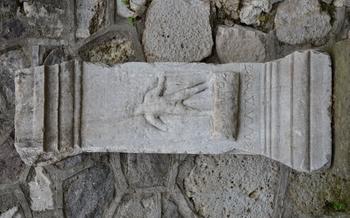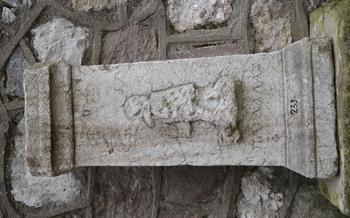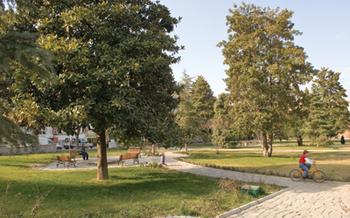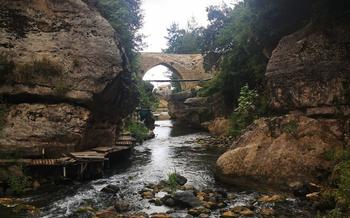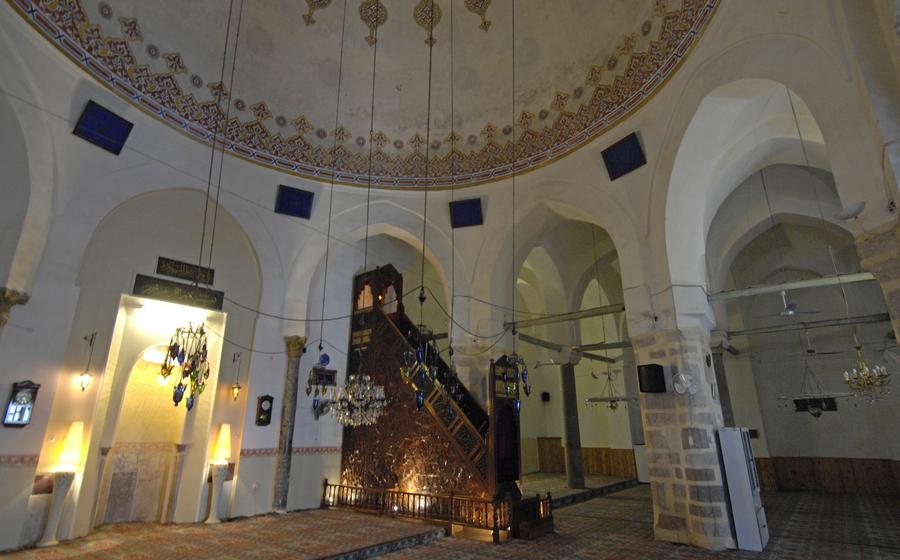
Sardes Antique City
- Historical Significance
- Sardis Archaeological Site: Unearthing History's Treasures
- The Acropolis: A Strategic Stronghold and Religious Center
- The Temple of Artemis
- The Gymnasium
- The Synagogue
- The Necropolis: A Journey into Ancient Lydian Burial Customs
- Local Cuisine
- Local Handicrafts
- Festivals and Events
- Accommodation Options
- Transportation
- Insider Tip: Discover the Hidden Treasure of Sardis - Bin Tepe Tumulus
Historical Significance
Sardis, an ancient city located in Manisa, Turkey, holds immense historical significance as the capital of the Lydian Kingdom, a powerful state that ruled over western Anatolia from the 7th to 6th centuries BC. The city's reputation and wealth reached legendary proportions under the rule of King Croesus, known for his immense riches, which led to the famous proverb "rich as Croesus." Sardis' strategic location, situated at the crossroads of trade routes, made it a flourishing center of commerce and industry. The city's influence extended beyond its borders, playing a crucial role in shaping the political and cultural landscape of the ancient world. Famous historical figures, such as Cyrus the Great, the founder of the Persian Empire, and Alexander the Great, the Macedonian conqueror, have left their mark on Sardis' rich history, adding to its enduring legacy.
Sardis Archaeological Site: Unearthing History's Treasures
The Sardis archaeological site is a treasure trove of ancient ruins and ongoing excavations, offering a glimpse into the city's glorious past. As you wander through the site, you'll encounter impressive structures that have withstood the test of time. Among them, the Temple of Artemis stands out with its majestic columns and intricate carvings, a testament to the city's religious devotion. The Gymnasium, with its palestra, wrestling arena, and baths, showcases the importance of physical training in ancient Greek culture.
One of the most significant discoveries at Sardis is the "Golden Sardis" hoard, a collection of gold and silver artifacts that provide valuable insights into Lydian art and craftsmanship. The hoard includes coins, jewelry, and other precious objects, offering a tangible connection to the city's legendary wealth.
Visitors to the Sardis archaeological site can explore these ruins and learn about the ongoing excavations, guided by knowledgeable experts who bring history to life. With its rich history and impressive remains, Sardis is a must-visit destination for anyone interested in ancient civilizations and archaeology.
The Acropolis: A Strategic Stronghold and Religious Center
Perched atop a hill overlooking the ancient city of Sardis, the Acropolis stands as a testament to the city's strategic importance and religious fervor. In its heyday, the Acropolis served as a formidable defensive stronghold, protecting Sardis from invading forces and providing a commanding view of the surrounding landscape. Its towering fortifications, remnants of which can still be seen today, once formed an impenetrable barrier, safeguarding the city's inhabitants from harm.
Beyond its military significance, the Acropolis held deep religious significance for the people of Sardis. It was home to several temples and other sacred structures, including the Temple of Cybele, the mother goddess of the Phrygians. Devotees would flock to the Acropolis to pay homage to their deities and participate in religious ceremonies and festivals.
As you explore the Acropolis, let your imagination transport you back in time. Picture the ancient Lydians, their colorful garments swirling as they ascended the hill to offer prayers and sacrifices. Imagine the sound of drums and cymbals echoing through the air as they celebrated their religious rituals.
Amidst the ruins, you can still discern the foundations of these sacred structures, each telling a story of faith and devotion. The remains of the Temple of Cybele, with its intricate carvings and imposing columns, stand as a testament to the architectural prowess of the Lydians.
Take a moment to sit on one of the ancient stone benches and soak in the breathtaking views from the Acropolis. Let the gentle breeze carry you back to a time when Sardis was a thriving metropolis, and the Acropolis stood as a symbol of its power and prosperity.
The Temple of Artemis
The Temple of Artemis, dedicated to the Greek goddess Artemis, stands as a testament to the grandeur of ancient Sardis. Constructed in the 6th century BC, this impressive structure was one of the largest temples in the ancient world, rivaling the Temple of Artemis in Ephesus. Its massive columns, intricately carved with Ionic capitals, towered over the city, symbolizing the power and wealth of the Lydian Kingdom.
The temple served as a center of religious ceremonies and festivals, attracting pilgrims from across the region. People came to pay homage to Artemis, the goddess of hunting, fertility, and childbirth, and to seek her blessings. The temple was also a place of economic importance, as it housed a treasury where the Lydian kings stored their vast wealth.
Legends and myths surround the Temple of Artemis. One legend tells of a young woman named Lyde who was chosen to be the temple's priestess. She was said to be so beautiful that men from all over the world came to see her, and her fame spread far and wide. Another legend recounts how the temple was spared from destruction by Alexander the Great when he conquered Sardis. Impressed by its beauty and grandeur, Alexander ordered his troops to leave the temple untouched.
Today, the ruins of the Temple of Artemis stand as a reminder of the splendor of ancient Sardis. Visitors can marvel at the massive columns, intricate carvings, and sheer size of the temple, imagining the grandeur of the religious ceremonies and festivals that once took place within its walls.
The Gymnasium
In the heart of Sardis, lies an impressive structure that once served as a hub for physical training and education - the Gymnasium. This vast complex, built in the 2nd century AD, stands as a testament to the importance of physical fitness in ancient Greek culture.
As you step through the gates, you'll be greeted by a large, open courtyard surrounded by a colonnade. Here, young men would gather to practice wrestling, boxing, and other athletic pursuits. The Gymnasium also featured a palestra, a spacious room with a sand-covered floor, where athletes would engage in various exercises and drills.
One of the most striking features of the Gymnasium is its wrestling arena, located at the far end of the courtyard. This circular arena, surrounded by stone benches, was the stage for fierce wrestling competitions. Imagine the roar of the crowd as two skilled wrestlers grappled for victory, demonstrating their strength and agility.
Beyond the wrestling arena, you'll find a complex of baths, essential for athletes to cleanse and refresh themselves after their rigorous training sessions. These baths consisted of hot, cold, and tepid pools, as well as changing rooms and massage rooms.
The Gymnasium was not merely a place for physical training but also for intellectual pursuits. It featured a library where athletes could study and learn from ancient texts on philosophy, history, and literature. This combination of physical and mental education prepared young men for not only military service but also for life as well-rounded citizens.
Exploring the Gymnasium today, you can't help but be impressed by its grandeur and the level of preservation. The stone benches, the intricate carvings, and the overall layout of the complex transport you back in time, offering a glimpse into the lives of ancient athletes and scholars.
The Synagogue
The Sardis Synagogue is a significant historical and religious site, believed to be one of the oldest synagogues in the world. Built during the Roman period, it stands as a testament to the vibrant Jewish community that once thrived in Sardis. The synagogue's well-preserved remains offer a glimpse into the religious and cultural life of the ancient Jewish community.
The synagogue's unique architectural features set it apart from other ancient synagogues. Its stone benches, arranged in rows, provided seating for worshippers during religious services. The Torah niche, a sacred space where the Torah scrolls were kept, is still visible within the synagogue. Additionally, the presence of a mikveh, a ritual bath used for purification, further highlights the synagogue's religious significance.
As a center of Jewish religious life and community, the Sardis Synagogue played a crucial role in preserving Jewish traditions and fostering a sense of belonging among its members. It served as a place for worship, prayer, and the study of Jewish scriptures. The synagogue's discovery has shed light on the rich history of Judaism in Sardis and its enduring legacy in the region.
Exploring the Sardis Synagogue is a unique and enriching experience. Visitors can admire its well-preserved architectural features, imagine the vibrant atmosphere during religious ceremonies, and reflect on the significance of this ancient place of worship. The synagogue stands as a reminder of the diverse religious and cultural heritage that has shaped the history of Sardis and the region.
The Necropolis: A Journey into Ancient Lydian Burial Customs
Beyond the city walls of Sardis lies an extensive necropolis, a vast expanse of ancient tombs that offer a glimpse into the burial customs and beliefs of the Lydians. These elaborate resting places, some dating back to the 7th century BC, showcase a variety of architectural styles and sizes, reflecting the social status and wealth of their occupants.
The most prominent tombs are the tumuli, or burial mounds, which dominate the landscape with their impressive size and grandeur. These earthen mounds, often several meters high, were reserved for the Lydian elite, including kings, queens, and wealthy individuals. Excavations have revealed a wealth of artifacts within these tumuli, including gold jewelry, pottery, weapons, and other precious objects, providing valuable insights into Lydian craftsmanship and artistic traditions.
In addition to the tumuli, the necropolis also features a variety of chamber tombs, rock-cut tombs, and sarcophagi. These tombs, often decorated with intricate carvings and inscriptions, offer a glimpse into the personal lives and beliefs of the deceased. Some tombs contain well-preserved frescoes and murals depicting scenes from mythology, daily life, and the afterlife, providing a vivid glimpse into the Lydian worldview.
Exploring the necropolis of Sardis is a journey through time, allowing visitors to connect with the ancient Lydians and gain a deeper understanding of their culture and funerary practices. It is a place where history comes alive, whispering tales of power, wealth, and the enduring legacy of a civilization that once flourished on these lands.
Local Cuisine
Manisa's local cuisine is a delightful blend of Turkish and Greek culinary traditions, offering a diverse range of flavors and dishes to tantalize your taste buds. A must-try is the famous Manisa kebab, tender and juicy grilled meat served with aromatic spices and fresh vegetables. For a unique and hearty dish, indulge in keşkek, a creamy stew made with wheat, meat, and yogurt, often served during special occasions. And don't miss the sweet and tangy üzüm pekmezi, a grape molasses that adds a delicious touch to desserts and pastries.
Venturing into the local markets, you'll find a treasure trove of fresh ingredients and delectable treats. Engage with the friendly vendors and sample their offerings, from succulent olives and tangy cheeses to fragrant herbs and seasonal fruits. Whether you prefer dining at traditional Turkish restaurants or exploring the street food scene, Manisa's culinary delights are sure to leave you satisfied and craving for more.
Local Handicrafts
Manisa is renowned for its vibrant local handicrafts scene, showcasing the skills and artistry of the region's artisans. Pottery, weaving, and jewelry-making are among the most prominent crafts that have been passed down through generations.
The Manisa Bazaar is a bustling marketplace where visitors can find an array of locally made handicrafts. From intricately painted pottery to colorful woven textiles, the bazaar offers a treasure trove of unique items. The Women's Cooperative is another excellent place to shop for local handicrafts, supporting women artisans and preserving traditional skills.
One of the highlights of Manisa's handicraft scene is its pottery. Artisans use local clay to create beautiful and functional pieces, often adorned with intricate patterns and vibrant colors. Visitors can watch the potters at work and even try their hand at creating their own pottery.
Weaving is another important craft in Manisa. Artisans use traditional looms to create colorful rugs, blankets, and other textiles. The patterns and designs often reflect the region's rich cultural heritage, making each piece a unique work of art.
Jewelry-making is also a thriving craft in Manisa. Artisans use gold, silver, and semi-precious stones to create intricate pieces of jewelry, often inspired by ancient Lydian designs. Visitors can find a wide variety of jewelry, from delicate necklaces and earrings to statement pieces that are sure to turn heads.
Purchasing local handicrafts is a wonderful way to support the artisans of Manisa and take home a piece of the region's cultural heritage. Whether you're looking for a unique souvenir or a special gift, you're sure to find something that catches your eye in Manisa's vibrant handicraft scene.
Festivals and Events
Manisa comes alive with vibrant festivals and events throughout the year, showcasing the city's rich cultural heritage and lively spirit. The Manisa International Music Festival is a must-attend event, featuring renowned musicians and performers from around the world. Held annually in July, the festival fills the air with melodies and rhythms, attracting music enthusiasts from near and far.
Another highlight is the Sardis Festival, which takes place in May or June. This festival celebrates the ancient city's glorious past, with traditional performances, reenactments, and exhibitions. Visitors can immerse themselves in the history of Sardis and experience the city's vibrant culture firsthand.
For those interested in local traditions, the Manisa Grape Festival is a must-visit. Held in September, this festival celebrates the region's famous grapes and wine production. Visitors can sample delicious local wines, enjoy traditional grape-based dishes, and participate in grape-stomping competitions.
These festivals offer a unique opportunity to experience the warmth and hospitality of the Manisa people, immerse yourself in the city's rich cultural traditions, and create lasting memories. Check the festival dates in advance to plan your visit accordingly and make the most of these vibrant celebrations.
Accommodation Options
Manisa offers a diverse range of accommodation options, catering to various budgets and preferences. For budget-conscious travelers, there are cozy guesthouses and hostels that provide basic amenities at affordable rates. These accommodations often have a friendly and social atmosphere, allowing guests to connect with fellow travelers and share experiences.
For a more comfortable stay, mid-range hotels offer a range of amenities such as private bathrooms, air conditioning, and breakfast included in the room rate. These hotels are typically located in convenient areas, within walking distance of major attractions and restaurants.
For those seeking a luxurious experience, Manisa boasts several upscale hotels that offer elegant accommodations, fine dining options, and spa facilities. These hotels are ideal for travelers who want to indulge in comfort and enjoy a memorable stay.
When choosing a hotel in Manisa, consider factors such as location, amenities, and budget. For a truly authentic experience, opt for a traditional Turkish guesthouse or a charming boutique hotel that reflects the local culture and hospitality.
Here are a few personal recommendations:
-
For a budget-friendly option, I highly recommend the Sardis Hostel. It's located in the heart of the city, just steps away from the Sardis ruins. The hostel offers clean and comfortable dormitory rooms, as well as private rooms with balconies overlooking the ancient city.
-
For a mid-range option, I suggest the Manisa Hotel. It's a family-run hotel with a warm and welcoming atmosphere. The hotel offers spacious rooms with modern amenities, and a delicious breakfast buffet is included in the room rate.
-
For a luxurious stay, the Lydian Palace Hotel is the place to be. This five-star hotel offers elegant rooms and suites, a rooftop pool with stunning city views, and a world-class spa.
No matter your budget or preferences, you're sure to find the perfect accommodation in Manisa to make your stay comfortable and enjoyable.
Transportation
Getting to Manisa is relatively easy, with several transportation options available. The city is well-connected by road, with regular bus services from major cities like Istanbul, Ankara, and Izmir. You can also take a train from Istanbul's Sirkeci Station to Manisa's Gar Station. Once in Manisa, getting around is convenient with public transportation, including buses and taxis. However, renting a car is recommended for exploring the surrounding area, including Sardis and other nearby attractions, at your own pace. The roads are well-maintained, and driving in Manisa is generally safe and hassle-free. Remember to carry your international driving permit if you plan to rent a car.
Insider Tip: Discover the Hidden Treasure of Sardis - Bin Tepe Tumulus
Venture off the beaten path and explore the Bin Tepe Tumulus, a hidden gem located just outside the ancient city of Sardis. This impressive burial mound, dating back to the 6th century BC, is believed to be the final resting place of wealthy Lydian nobles. As you approach the tumulus, its sheer size and grandeur will captivate you. Climb to the top for breathtaking panoramic views of the Sardis plain and the surrounding mountains. While little is known about the specific individuals buried here, the tumulus offers a glimpse into the lavish burial practices of the Lydian elite. Imagine the grandeur and opulence that once adorned this site, and let your mind wander back in time to the days of King Croesus and his legendary wealth.

